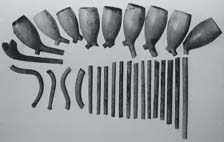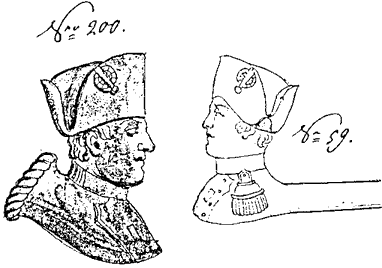|

|
No. 8/1996, p. 1-44
Ralph Röber: Clay pipes from Constance
| The clay pipes from Constance cover
a period of about 250 years. During this time span, not only their
shape underwent changes but also their provenance. In the 17th
century most of the clay pipes appear to have been produced by
pipe makers who had settled relatively locally. In addition there
are a few imported pipes from the Neckar-Rhine confluence area
and from the Netherlands. During the course of the 18th century
the local factories seem to have completely disappeared. The pipes
from this period display a high degree of uniformity; a large
proportion are inferred to originate from Westerwald. The 18th
century clay pipes also display an increase in abundance. Amongst
the pipe finds from archaeological excavations in Constance there
are seven 17th century pipe bowls and eighteen dating from the
18th century. We see a similar pattern amongst pipes found in
the fields on the Tägermoos, i.e. five fragments of 17th
century pipes and twelve from the 18th century. There are many
pipe bowls which cannot be exactly identified and are quite likely
to belong to the latter period. |
| The 19th century pipes comprise a fairly heterogeneous
collection indicating scattered sources of supply. The pipes from
Westerwald can be identified with reasonable certainty; similarly
those from France are moderately easy to recognize. One Austrian-made
pipe was found. Unfortunately the majority of pipes are still
unidentified as regards their place of manufacture. |
|

Eighteenth century clay pipes from the Brückengasse,
Konstanz
|

|
|
No. 8/1996, p. 45-50
Andreas Wilts: Strong tobacco. Tobacco consumption and laws prohibiting
its use in Constance in the 17th and 18th centuries
The first mention of tobacco as a commodity in the books of the
"Konstanzer Kaufhaus" (the Constance General Stores) found
during archives research is from 1633. The consumption of tobacco
in one form or another became increasingly popular; numerous and
repeated prohibition orders in Constance (1670 and 1675) and in
other towns on and near Lake Constance did not succeed in stopping
its spread. At the end of the 17th century tobacco smoking was not
only widespread, but, as several sources describe, was popular with
all classes and age groups (including children), as well as with
both sexes. From the second half of the 18th century onwards, tobacco
was grown locally for sale, and around 1764-66 the first factory
to produce smokers' tobacco and snuff was established. Tobacco growing,
however, was not altogether successful and did not achieve any great
commercial importance.

|
|
|

Clay-pipe bowl
displaying four faces,
provenance unknown,
mid 17th century
|
No. 8/1996, p. 50-61
Michael Schmaedecke: The status of clay-pipe research in Switzerland
- an initial overview
As early as the beginning of this century, clay-pipe
finds were objects of intensive study in Switzerland; however,
they were erroneously assigned to ancient Greek or Roman times
or even prehistoric times. This material, which in most cases
is now only available as figures in publications, has not yet
been restudied with a view to reinterpreting it. It is only relatively
recently that clay pipes have begun to receive the attention they
deserve as archaeological finds; however, no detailed work has
been done yet.
A preliminary analysis of the published reports on clay pipes
found in Switzerland shows that, apart from imports from the Netherlands,
clay pipes were also obtained from Frankenthal at quite an early
date (about 1650). In the 18th century, pipes were increasingly
imported from Westerwald. This particular trade will form the
subject of a future study. Little is known so far about the origin
of stub-stemmed pipes, which might have come from France and from
the Near East.
|
|

"Rauracher-Amazone",
woodcut, 19th century
|

|
No. 8/1996, p. 61-79
Martin Kügler: The market for Westerwald clay pipes in southern
Germany, France, Switzerland, and northern Italy at the beginning
of the 19th century
Around 1800, the Westerwald pipemakers' export trade down the Rhine
declined rapidly as a consequence of the wars of revolution and
as a result of the high import and transit duties levied by the
Netherlands. The Westerwald pipemakers were, however, successful
in expanding trade with the south, and Switzerland developed into
an important export market. Two account books from 1802-1806 and
1826-1830 give exact sales figures and names of customers in southern
Germany, Switzerland, Italy, Austria, and France.
Preliminary evaluation of these sales statistics shows up the sometimes
quite sudden changes in the market. The account books also provide
information about the organisation of the shops that sold clay pipes,
about how orders were obtained, the transport routes, and the different
pipe models. The names of the various models mentioned in the account
books rarely give any idea of what the pipes really looked like.
However, pipes and pipe bowls bearing a portrait of Napoleon Bonaparte
are identifiable; sales figures for these particular pipes and the
countries that they were exported to are quoted for the period between
1826 and 1830.

Pipe bowls showing portrait of Napoleon Bonaparte,
taken from the catalogue of the firm Müllenbach & Thewald,
Höhr, 1830s
|

No. 8/1996, p. 80-87
Lutz Jansen: The tobacco trade in Vogtland, Saxony. Report on
a remarkable ceramic find from Reichenbach
Excavations carried out on a cesspit yielded a piece of a very large
clay pipe bowl (height of complete bowl 11 cm). The pipe bowl bears
the face of a man with a moustache. The design reminds one of the
"Jonas and the whale" pipes, but the face is not directed
towards the smoker of the pipe; it is on one side of the pipe bowl.
Small holes, which were drilled after the pipe had been fired, enabled
the pipe to be hung up. It is therefore likely that the bowl is
part of a presentation pipe or an advertisement which was once hung
up inside or outside a shop, perhaps an apothecary's shop, to draw
customers' attention to the sale of pipes and tobacco. The age of
the pipe is not certain (around 1700 ?) and it is not known where
it was made, although it is unlikely to be an import from the Netherlands.

No. 8/1996, p. 87-90
Martin Kügler: Report on the 9th meeting of the German Society
for Clay-Pipe Research held in Constance on 6 and 7 May 1995
Altogether 24 people attended the meeting, which was held in Constance
at the kind invitation of the Constance branch of the Baden-Württemberg
State Archaeological Museum. The extensive collection of clay-pipes
found in Constance was described by R. Röber, and put into
historical perspective by A. Witts, who gave a paper on the history
of tobacco consumption around Lake Constance (Knasterkopf No. 8/1996,
p. 1-44 and 45-50, respectively). M. Schmaedecke gave the first
account of clay-pipe finds from Switzerland, and M. Kügler
gave an account of the export of Westerwald clay pipes to SW Germany
and Switzerland at the beginning of the 19th century (Knasterkopf
No. 8/1996, p. 50-61 and p. 61-79, respectively). W. Morgenroth
presented a paper on the competition between wooden pipes and clay
pipes, E. Reiff gave an account of clay pipes found in mine dumps
in the Harz Mountains (Knasterkopf No. 7/1995, p. 50-63) and Lutz
Libert showed a historical video film about tobacco growing in Uckermark.
|
|
